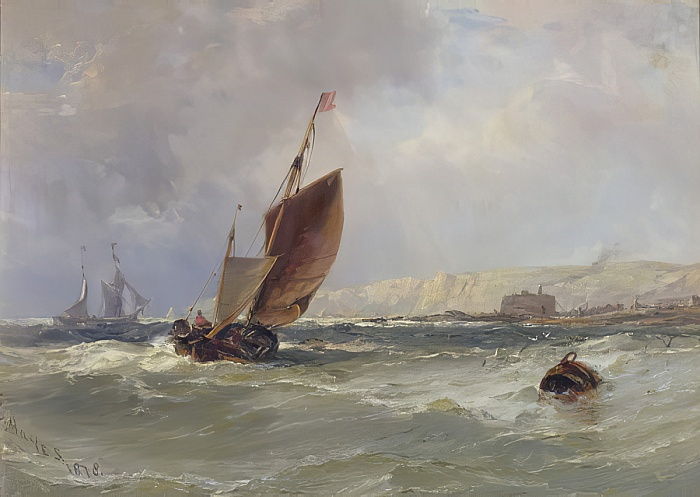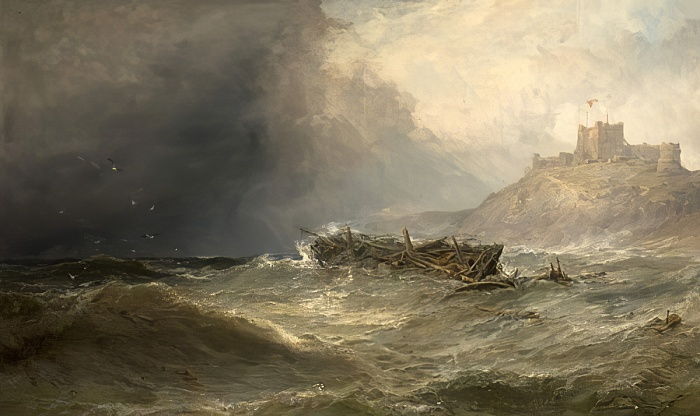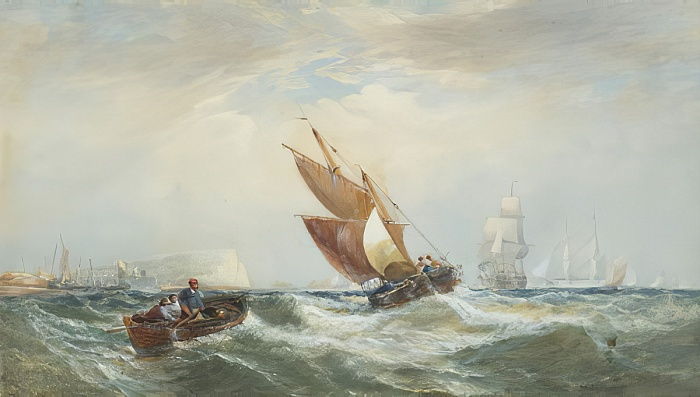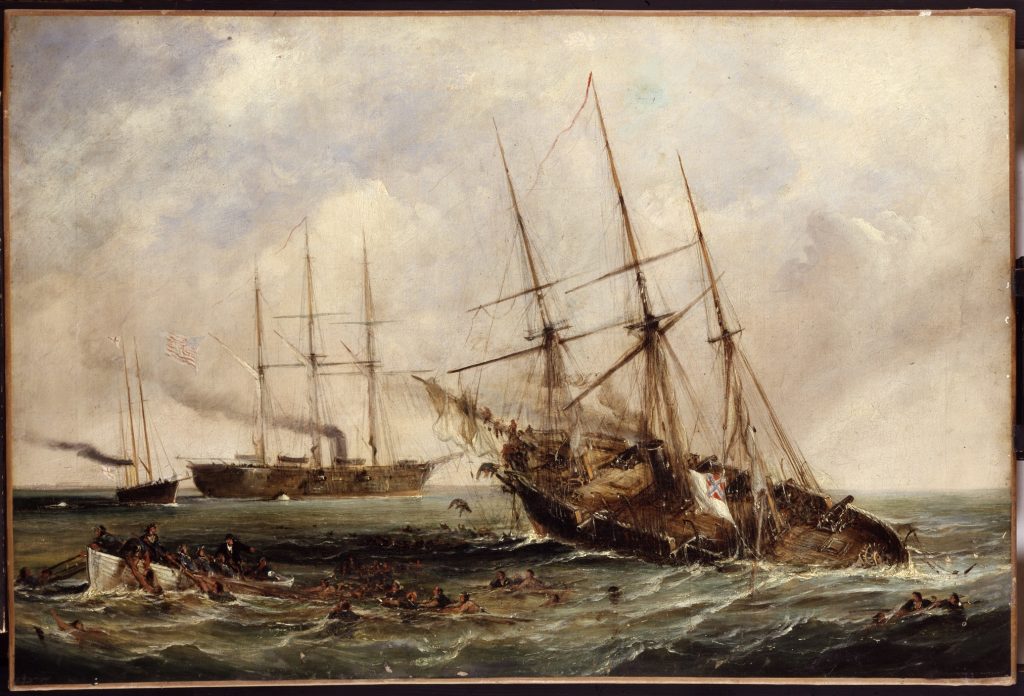My Hunt for the C.S.S. Alabama
Among my first introductions to the American Civil War was Robert Paul Jordan’s 1969 book The Civil War. It was a volume in a series of National Geographic Society illustrated books. Most were about regions, but there were the odd historical tomes. The book on the Vikings left quite an impression, but Jordan’s The Civil War stuck out. Not so much the personalized narrative, which is passable if at times distracting. More impressive were the paintings and illustrations. Several of them I have not seen in any other book, including a dramatic depiction of the 54th Massachusetts attacking Battery Wagner, a lone Union drummer boy on a foggy morning, and a trio of Southerners (a slave woman, southern belle, and Rebel soldier) looking in horror as a cannonball lands in front of them during the shelling of Vicksburg.
The one that I gazed at the longest was the sinking of the C.S.S. Alabama. It is curious that this painting never elicited a strong interest in the battle or the storied careers of the ships involved. I know generally of the Alabama’s impressive voyage, but it did not draw me in. Of nautical matters, I would later take more interest in R.MS. Titanic and the battleship Bismarck. My attraction was more to the visual elements. The painting is a blend of sorts between impressionism and realism. Impressionism at its best suggests memory and movement, and the painting is like a reconstructed memory of an event, with artistic flourishes. You can see men leaping into the sea or struggling aboard the lifeboat. The American flag flies high and straight but looks faded. The Confederate flag is vibrant and flies away from the water, defiantly fleeing the inevitable doom of the ship. The fate of the cause was a little less certain when the vessel went down. Alabama sank on June 19, a day after a major Confederate victory at Petersburg. The painting was crafted in 1864 although whether it was before or after the fall of Atlanta is unknown.
My love of art and obsession with the war has led me to search out artistic recreations of the conflict. There are good novels, poems, movies, and games, but I find the music and visual art to be my favorites. I have no reason beyond both are often more immediate than the written word, and convey a fast visceral reaction. My search for the painting was hard though. The only images online were small and did it no justice. I noted that in Jordan’s book, it was attributed to Edwin Hayes and owned by the Chicago Historical Society. After some digging, I found that the society’s holdings were with the Chicago History Museum. However, it was not listed among their holdings online. After a variety of emails the painting was found and I decided to buy a high resolution scan. It might be the most frivolous purchase of my life, but I wanted it. In the Jordan book, it is impressive but split by the spine. Now I can see it in its full glory.
Edwin Hayes is something of a mystery. According to various Internet websites devoted to art, he was born in Bristol in 1820, where his father owned the Bristol Hotel and Tavern on Marlborough Street. However, Hayes grew up in Dublin. He studied at the Dublin Society Art School and became a maritime artist. Much of it was due to his life choices. He was a sailor for much of his youth and apparently lived near the docks. His first exhibit was in 1842 at the Royal Hibernian Academy. He moved to London in 1852. In 1854 he had breakthrough success at the British Institution with View of the River Liffey and the Custom House. He did a show at the Royal Academy of Arts in 1855. He would show his work there for fifty years. He also had showings at the Society of British Artists and the Royal Institute of Painters in Watercolours, becoming a full member of the latter in 1863. In 1871 he was made a member of the Royal Hibernian Academy. Given his upbringing, subject matter, and popularity in Ireland, he is typically associated with that country.

Hayes’ works were mostly slice of life depictions of the coasts of Europe. Subjects included places in Ireland, England, Belgium, Holland, France, Spain, and Italy. Of his work, I have noted a love of waves, of the sea in revolt. It is said Hayes was inspired by J. M. W. Turner’s work, such as Calais Pier with French Poissards Preparing for Sea, an English Packeet Arriving and The Slave Ship (also known as Slavers Throwing overboard the Dead and Dying—Typhoon coming on). Even if not showing a full storm, the waves in Hayes’ paintings are usually choppy and sometimes cover half of the canvas. Indeed, he was praised most for his ability to depict water in all its forms, but most were impressed with the scenes of crashing waves. Yet, his work was of an academy style that fell out of favor among the purveyors of high taste. The nineteenth century saw a variety of artists who were realists, but also given to romantic or impressionist flourishes as needs required. Many were conservative in subject, such as paintings of military moments and great historical events. Although such works became out of fashion, they are still beloved, sought after, and can fetch a handsome price. Hayes never reached the front rank but he appears to have had steady success in a chaotic world. He also lived and worked for a long time, dying in 1904.

In 1864 Hayes crafted Destruction of the Confederate Steamer Alabama by the Kearsarge, 1864 (Chicago History Museum, ICHi-062518). What led him to paint the battle remains unknown. Historical events do not seem to have been a subject he often dealt with. He may have witnessed the battle from Cherbourg, but I suspect that he met the crew and was commissioned by them or a member of Deerhound. The yacht was owned by John Lancaster, a Lancashire businessman who later became a Liberal MP from 1868 to 1874. He was very wealthy and he seems a likely candidate, particularly as his yacht features fairly prominently in the painting, coming to rescue Confederate sailors. In addition, the painting is from a Confederate point of view given the prominence of the ship, flag, and its crew. Yet, how did the painting come to Chicago? Of that I cannot say.

Either way, I think Hayes’ work is outstanding, an under-appreciated classic of the military and nautical genres. Naturally Hayes was not alone in depicting the sinking. Xanthus Russell Smith, Louis Le Breton, and most famously Édouard Manet each took a stab at the subject. Manet’s work is the better known and is a fine painting, with a dark and somber feeling. Hayes’ work is a study in contrasts. The U.S.S. Kearsage appears sturdy and undamaged next to the doomed Alabama, while Deerhound speeds in to save the shipwrecked Rebels. The sea churns around the wreck, while elsewhere it looks like a flat calm. There is a certain glow to the sky as a maritime legend plunges, defiant but doomed.
In getting the painting, I would like to thank the staff of the Chicago History Museum, particularly Julie Katz.

Persuasive proposal that “an image” seen while young can have long-lasting effects: in my own case, it was a confronting image on display at Lincoln’s Tomb in Springfield that sparked my interest in the real story of the Lincoln Assassination; and ultimately the Civil War. The following link is to an image held by the Naval History and Heritage Command that I encountered recently: the clarity, even when expanded close-up, gives the impression of having been taken “Just the other day” (and has a connection to your tale of CSS Alabama) https://www.history.navy.mil/content/history/nhhc/our-collections/photography/us-people/k/kell-john-mcintosh/nh-42383.html
Thanks for showcasing some compelling art. Those pictures brim with sharp action.
Thanks. I wish Hayes had done more war subjects, but as it stands his one foray is impressive.
I have a print of Manet’s work hanging in my office (along with prints of the battles in which I participated in as a reenactor during the sesquicentennial)
Great painting of the Alabama-Kearsarge engagement. I’m a fan of marine art but haven’t seen that one before. Thanks.
That NatGeo Civil War book was my first Civil War book too, still have it, AND the “Vikings” one also.
This story reminds me of the artifacts and letter which were lost decades ago after loaning them to professor Lord and his the museum at Norwich University in Northfield, VT.
I had a letter on a shoe company letter heads which read:
Dear Mrs. Lyndsay,
When in the Boston Navy yard I obtained specimens from the sturdy planks of the Kearsarge. I also got a piece of one of the Alabama’s life boats, probably where that old pirate Semes placed his aft side.
–McDowell
I often wondered who Mrs. Lyndsay was? And I also wondered if this letter was written by General McDowell ?
I still wonder who stole these items from me and where they are now ?
The Alabama-Kearsarge Duel is filled with ironies. The first is that Winslow was a Southerner (born in North Carolina) and Semmes a Northerner (born in Maryland). Second is that they served together aboard USS Cumberland and USS Raritan in the Mexican War, were messmates and even shared a stateroom and a wardrobe, thereby becoming fast friends. Third is that both commanders found themselves swimming for their lives in Mexican waters after they lost the ships they were commanding (the Morris and the Somers, respectively). Fourth is that one of the US warships that blockaded Semmes at Gibraltar when he was in command of the CSS Sumter was the USS Kearsarge, though she was not under the command of Winslow at the time. Fifth is that both mariners were promoted to the rank of Commander in 1855. Sixth is that Semmes and 41 of his officers and crew, who were rescued by the English yacht Deerhound, owed their lives to the vote of a 9-year old girl, Catherine Lancaster, the daughter of the yacht’s owner, John, who, when she was asked to cast the deciding vote as to what the family would do with their Sunday morning, voted to watch a sea battle. Seventh is that Alabama scored a direct hit on the sternpost of Kearsarge, which would surely have sent her to the bottom if the shell had exploded, which it did not, because of the malfunction of a percussion cap. And eighth, and last, is that Secretary of the Navy, Gideon Welles, instead of praising Winslow for his victory, criticized him for his “gross error of judgment” in paroling “foreign pirates captured on board the Alabama”. Sic transit Gloria mundi.
Thanks for the facts. I will say though Maryland is not a northern state, at least at that time, but Semmes is of course mostly recalled in conjunction with the state of Alabama.
Sean, I would say that Maryland’s antebellum status is arguable. Lower Maryland had strong Southern sympathies, true, but northern and western Maryland were strongly Unionist. It is below Mason’s and Dixon’s Line, true, but it never seceded from the Union. .
The Lincoln administration’s strenuous efforts in 1861 to keep that state in the union show it was hardly a unionist hotbed. The degree to which it favored one side or the other is hard to quantify. It certainly provided thousands of soldiers to both sides. It was certainly a border state of conflicted loyalty.
I will say I know more about Kentucky given my research and family background. My family fought on both sides.
At one time I had specimens from both the Kearsarge and one of the Alabama’s lifeboats. These came in a box with a letter from General McDowell to a Mrs. Lyndsay who received these from the general. The letter read something like this..”When in the Boston Navy Yard the Kearsarge put in for repairs and I send you these from one of the Kearsarge’s stern planks and also one from one of the Alabama’s lifeboats from which that old pirate Semmes probably placed his aft side.” Unfortunately, I loaned thes.e to Norwich University’s museum and never got them back. So they likely still survive as stolen items in the collection of a cadet named David Patten or the curator, Dr. Lord who was in charge of the museum in Northfield
, Vermont